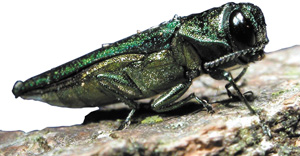by Jerome Delbridge, Certified Arborist, Weekly View Correspondent
A visit to Indianapolis’s northeast side and Carmel reveals thousands of dead and dying trees along the side of the road. These trees are ash trees, and they are quickly being killed by a small insect called the emerald ash borer (EAB). Since its accidental introduction to the Detroit area in 2002, tens of millions of trees have been killed by this pest. Nearly all untreated ash trees in an infested neighborhood will be killed by this insect within a few short years. This is the most destructive forest pest ever seen in North America and we can now assume it is throughout all of the Indianapolis area. 
Fortunately, highly effective and safe treatment options are available to protect trees from dying from this metallic green colored insect. But treatment is not always the best option.
Most of the ash trees in Indianapolis are native trees that make great city trees. They are hardy with a desirable shape and beautiful fall color. Your ash tree may be important to your landscape, or it may cool your home in the summer heat. You may also want to save your ash tree simply because you can’t afford to remove it. If you have an ash tree that is healthy (with more than half its canopy), structurally sound, and growing in a location that will not conflict with surroundings, it most likely makes sense to save your tree.
There are two treatment options to save your ash trees. If your tree’s trunk is 20 in. wide or smaller, you can treat it yourself. You can buy a systemic insecticide labeled to control emerald ash borer that contains the chemical imidacloprid. (To measure your tree, take a tape measure, and measure 54” from the ground. At this point, measure how many inches there are around the tree trunk. Divide this measurement by 3. If this number is 20 or less, you can treat your tree yourself or hire a professional.) Treat your trees according to label directions between April 1 and May 15 every year. If you are treating multiple trees, follow the label directions on the amount to be be applied in an area. This chemical travels to the leaves of the tree and kills the adult beetles during their short time as adults.
There are a few professional treatment options, but research shows that injecting the chemical Emamectic benzoate (trade name Tree-äge) into the trunk of the tree has the highest level of control. This treatment is also only needed once every two years. This treatment works by killing the destructive larvae and the adult beetles.
The emerald ash borer has not yet caused severe damage to many ash trees in Indianapolis’ East side neighborhoods. This gives us an opportunity to preventatively treat our trees and protect them from damage. If trees are left untreated and become damaged, they will never make a full recovery, even if treated after the infestation.
To find an ISA certified arborist who can protect your tree, visit treesaregood.org or saveyourash.com.
Jerome Delbridge is an ISA Certified Arborist IN-3334A and owner of Tree-Centric Solutions, an eastside company offering tree treatment, residential fruit tree planting and care, and tree advice. www.tree-centric.com 317-605-9802



